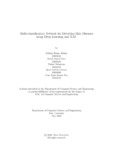Multi-classification Network for Detecting Skin Diseases using Deep Learning and XAI
Date
2022-05Publisher
Brac UniversityAuthor
Athina, Fahima HasanSara, Sadaf Ahmed
Tabassum, Nishat
Sarwar, Quazi Sabrina
Jannat Era, Mun Tarin
Metadata
Show full item recordAbstract
This research work aims to show a comparative analysis among four different deep
learning approaches to classify three rare but deadly skin diseases namely Stevens Johnson Syndrome, Erythema Multiforme and Bullous Pemphigoid. As the features of these diseases often overlap with each other, it becomes challenging for
physicians to distinguish them with their naked eye. Thus, this research work is
initiated to find a model that provides an efficient way to identify them for preventing misdiagnosis. This work also attempts to interpret the prediction of these
models using LIME based Explainable Artificial Intelligence (XAI). Here, the four
pre-trained models namely ResNet50V2, VGG16, Inceptionv3 and InceptionRes NetV2 have been used for feature extraction. The top layer of these models have
been replaced with a customized 10-layer architecture consisting of Convolution,
BatchNormalization, Dropout and Dense Layers. These models have been trained
on a hybrid dataset comprising of colored images of the diseases collected from dif ferent sources. Moreover, different machine learning classification algorithms (i.e.
Random Forest, Logistic Regression, and Support Vector Machine) have been used
to classify the images to see how well they perform compared to a neural network
approach. Lastly, the accuracy of the attempted models have been compared with
each other to identify which algorithm shows the best performance. The analysis
shows that the InceptionResnetV2 model provides the highest accuracy of 99.06%
while InceptionV3, VGG16 and Resnet50V2 provide 90.27%, 95.92% and 98.26%
respectively.

